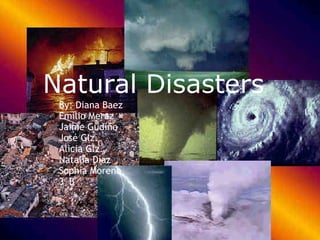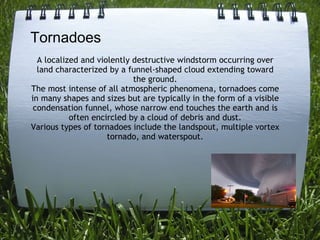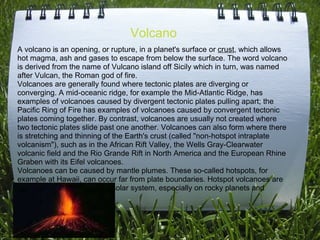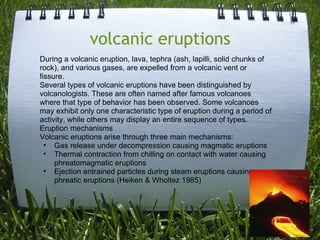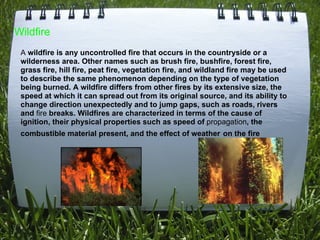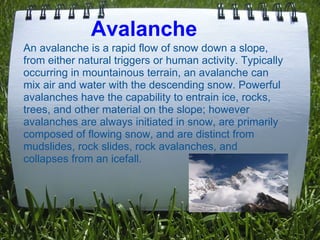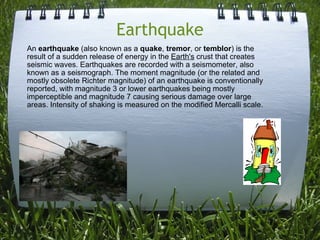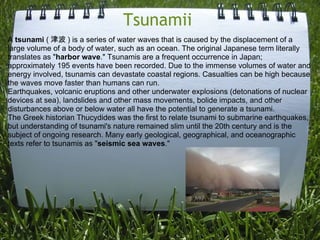Desastres
- 1. Natural Disasters By: Diana Baez Emilio Meraz Jaime Gudi?o Jos└ Glz. Alicia Glz. Natalia D┴az Sophia Moreno 3<B
- 2. A?localized and violently destructive windstorm occurring over land characterized by a funnel-shaped cloud extending toward the ground. The most intense of all atmospheric phenomena, tornadoes come in many shapes and sizes but are typically in the form of a visible condensation funnel, whose narrow end touches the earth and is often encircled by a cloud of debris and dust. Various types of tornadoes include the landspout, multiple vortex tornado, and waterspout. Tornadoes
- 3. Volcano A volcano is an opening, or rupture, in a planet's surface or crust , which allows hot magma, ash and gases to escape from below the surface. The word volcano is derived from the name of Vulcano island off Sicily which in turn, was named after Vulcan, the Roman god of fire. Volcanoes are generally found where tectonic plates are diverging or converging. A mid-oceanic ridge, for example the Mid-Atlantic Ridge, has examples of volcanoes caused by divergent tectonic plates pulling apart; the Pacific Ring of Fire has examples of volcanoes caused by convergent tectonic plates coming together. By contrast, volcanoes are usually not created where two tectonic plates slide past one another. Volcanoes can also form where there is stretching and thinning of the Earth's crust (called "non-hotspot intraplate volcanism"), such as in the African Rift Valley, the Wells Gray-Clearwater volcanic field and the Rio Grande Rift in North America and the European Rhine Graben with its Eifel volcanoes. Volcanoes can be caused by mantle plumes. These so-called hotspots, for example at Hawaii, can occur far from plate boundaries. Hotspot volcanoes are also found elsewhere in the solar system, especially on rocky planets and moons.
- 4. ? ? volcanic eruptions During a volcanic eruption, lava, tephra (ash, lapilli, solid chunks of rock), and various gases, are expelled from a volcanic vent or fissure. Several types of volcanic eruptions have been distinguished by volcanologists. These are often named after famous volcanoes where that type of behavior has been observed. Some volcanoes may exhibit only one characteristic type of eruption during a period of activity, while others may display an entire sequence of types. Eruption mechanisms Volcanic eruptions arise through three main mechanisms: Gas release under decompression causing magmatic eruptions Thermal contraction from chilling on contact with water causing phreatomagmatic eruptions Ejection entrained particles during steam eruptions causing phreatic eruptions (Heiken & Wholtez 1985)
- 5. Wildfire A wildfire is any uncontrolled fire that occurs in the countryside or a wilderness area. Other names such as brush fire, bushfire, forest fire, grass fire, hill fire, peat fire, vegetation fire, and wildland fire may be used to describe the same phenomenon depending on the type of vegetation being burned. A wildfire differs from other fires by its extensive size, the speed at which it can spread out from its original source, and its ability to change direction unexpectedly and to jump gaps, such as roads, rivers and fire breaks. Wildfires are characterized in terms of the cause of ignition, their physical properties such as speed of propagation , the combustible material present, and the effect of weather on the fire
- 6. Avalanche An avalanche is a rapid flow of snow down a slope, from either natural triggers or human activity. Typically occurring in mountainous terrain, an avalanche can mix air and water with the descending snow. Powerful avalanches have the capability to entrain ice, rocks, trees, and other material on the slope; however avalanches are always initiated in snow, are primarily composed of flowing snow, and are distinct from mudslides, rock slides, rock avalanches, and collapses from an icefall.
- 7. Earthquake An earthquake (also known as a quake , tremor , or temblor ) is the result of a sudden release of energy in the Earth's crust that creates seismic waves. Earthquakes are recorded with a seismometer, also known as a seismograph. The moment magnitude (or the related and mostly obsolete Richter magnitude) of an earthquake is conventionally reported, with magnitude 3 or lower earthquakes being mostly imperceptible and magnitude 7 causing serious damage over large areas. Intensity of shaking is measured on the modified Mercalli scale.
- 8. Tsunamii A tsunami ( 薯襖 ) is a series of water waves that is caused by the displacement of a large volume of a body of water, such as an ocean. The original Japanese term literally translates as " harbor wave ." Tsunamis are a frequent occurrence in Japan; approximately 195 events have been recorded. Due to the immense volumes of water and energy involved, tsunamis can devastate coastal regions. Casualties can be high because the waves move faster than humans can run. Earthquakes, volcanic eruptions and other underwater explosions (detonations of nuclear devices at sea), landslides and other mass movements, bolide impacts, and other disturbances above or below water all have the potential to generate a tsunami. The Greek historian Thucydides was the first to relate tsunami to submarine earthquakes, but understanding of tsunami's nature remained slim until the 20th century and is the subject of ongoing research. Many early geological, geographical, and oceanographic texts refer to tsunamis as " seismic sea waves ."
